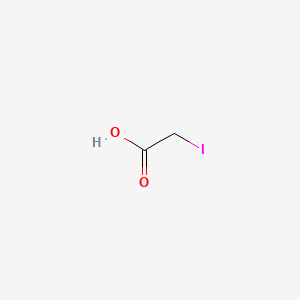D1412 | iodoacetate
| Toxicity | Dose | Time | Species | Model | Method | Action | Positive criterion | Reference |
|---|---|---|---|---|---|---|---|---|
| GLYCOLYSIS | inhibition | 278 | ||||||
| Target | Dose | Time | Species | Model | Method | Action | Positive criterion | Reference |
|---|---|---|---|---|---|---|---|---|
| Glyceraldehyde-3-phosphate dehydrogenase | inhibit | 278 | ||||||
| Pictogram | Signal | Statements | Precautionary Statement Codes |
|---|---|---|---|
  |
Danger |
H301: Toxic if swallowed [Danger Acute toxicity, oral] H314: Causes severe skin burns and eye damage [Danger Skin corrosion/irritation] |
P260, P264, P270, P280, P301+P310, P301+P330+P331, P303+P361+P353, P304+P340, P305+P351+P338, P310, P321, P330, P363, P405, and P501; (The corresponding statement to each P-code can be found at the GHS Classification page.) |
  |
Danger |
Aggregated GHS information provided by 49 companies from 2 notifications to the ECHA C&L Inventory. Each notification may be associated with multiple companies. H301 (100%): Toxic if swallowed [Danger Acute toxicity, oral] H314 (100%): Causes severe skin burns and eye damage [Danger Skin corrosion/irritation] Information may vary between notifications depending on impurities, additives, and other factors. The percentage value in parenthesis indicates the notified classification ratio from companies that provide hazard codes. Only hazard codes with percentage values above 10% are shown. |
P260, P264, P270, P280, P301+P310, P301+P330+P331, P303+P361+P353, P304+P340, P305+P351+P338, P310, P321, P330, P363, P405, and P501; (The corresponding statement to each P-code can be found at the GHS Classification page.) |
  |
Danger |
H301: Toxic if swallowed [Danger Acute toxicity, oral] H314: Causes severe skin burns and eye damage [Danger Skin corrosion/irritation] |
P260, P264, P270, P280, P301+P310, P301+P330+P331, P303+P361+P353, P304+P340, P305+P351+P338, P310, P321, P330, P363, P405, and P501; (The corresponding statement to each P-code can be found at the GHS Classification page.) |
   |
Danger |
H301: Toxic if swallowed [Danger Acute toxicity, oral] H314: Causes severe skin burns and eye damage [Danger Skin corrosion/irritation] H317: May cause an allergic skin reaction [Warning Sensitization, Skin] H318: Causes serious eye damage [Danger Serious eye damage/eye irritation] |
P260, P261, P264, P270, P272, P280, P301+P310, P301+P330+P331, P302+P352, P303+P361+P353, P304+P340, P305+P351+P338, P310, P321, P330, P333+P313, P363, P405, and P501; (The corresponding statement to each P-code can be found at the GHS Classification page.) |
   |
Danger |
H301: Toxic if swallowed [Danger Acute toxicity, oral] H310: Fatal in contact with skin [Danger Acute toxicity, dermal] H314: Causes severe skin burns and eye damage [Danger Skin corrosion/irritation] H318: Causes serious eye damage [Danger Serious eye damage/eye irritation] H371: May cause damage to organs [Warning Specific target organ toxicity, single exposure] H373: Causes damage to organs through prolonged or repeated exposure [Warning Specific target organ toxicity, repeated exposure] |
P260, P262, P264, P270, P280, P301+P310, P301+P330+P331, P302+P350, P303+P361+P353, P304+P340, P305+P351+P338, P309+P311, P310, P314, P321, P322, P330, P361, P363, P405, and P501; (The corresponding statement to each P-code can be found at the GHS Classification page.) |
| Organism | Test type | Route | Dose (normalized dose) | Effect | Source |
|---|---|---|---|---|---|
| rat | LD50 | intraperitoneal | 75mg/kg (75mg/kg) | Russian Pharmacology and Toxicology Vol. 41, Pg. 113, 1978. | |
| rabbit | LDLo | subcutaneous | 60mg/kg (60mg/kg) | Journal of Physiology. Vol. 80, Pg. 360, 1934. | |
| dog | LD50 | intravenous | 45mg/kg (45mg/kg) | Journal of the National Cancer Institute. Vol. 31, Pg. 297, 1963. | |
| guinea pig | LD50 | skin | 125mg/kg (125mg/kg) | skin and appendages (skin): "dermatitis, other: after systemic exposure" | National Technical Information Service. Vol. OTS0571891, |
| rat | LCLo | inhalation | 94gm/m3/30M (94000mg/m3) | Russian Pharmacology and Toxicology Vol. 41, Pg. 113, 1978. | |
| rat | LD50 | subcutaneous | 60mg/kg (60mg/kg) | Toxicology and Applied Pharmacology. Vol. 26, Pg. 93, 1973. | |
| rat | LD | parenteral | > 4uL/kg (0.004mL/kg) | brain and coverings: other degenerative changes | Journal of Neurochemistry. Vol. 69, Pg. 285, 1997. |
| rat | LD | parenteral | > 4uL/kg (0.004mL/kg) | Journal of Neurochemistry. Vol. 69, Pg. 285, 1997. | |
| dog | LD50 | intravenous | 45mg/kg (45mg/kg) | lungs, thorax, or respiration: other changes | Journal of the National Cancer Institute. Vol. 31, Pg. 297, 1963. |
| CAS Number | 108481-92-1, 64-69-7, 66322-65-4 |
| PubChem Compound | 5240 |

